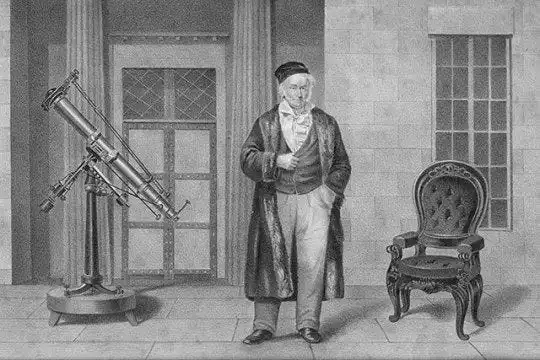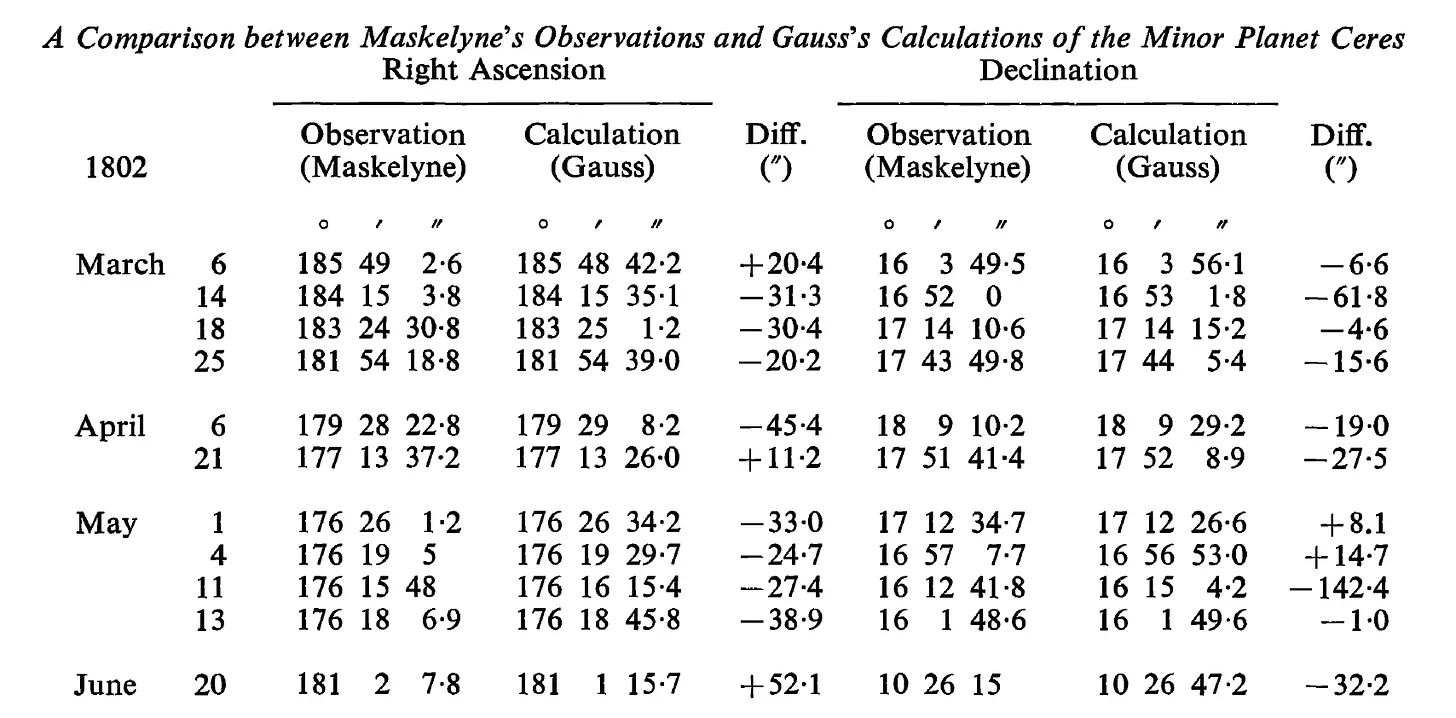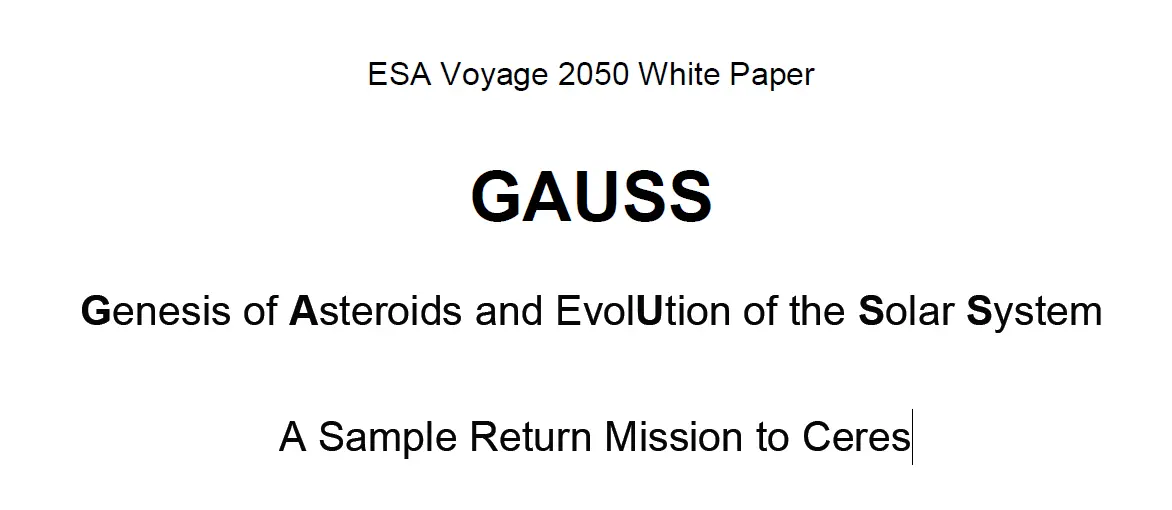“Nowhere in the annals of astronomy do we meet with so great an opportunity, and a greater one can hardly be imagined, for most strikingly, the value of this problem,…,when all hope of discovering in the heavens this planetary atom, among innumerable small stars after lapse of nearly a year, rested solely upon a sufficiently approximate knowledge of its orbit to be based on these very few observations.

Carl Friedrich Gauss (1777-1855)
A DWARF AMONG THE GIANTS
This is a story, a story about the intersection of two prominent fields within the natural sciences, resulting in the emergence of something both exquisite and rigorous.
It begins at the beginning of the 19th century. In Europe, the field of astronomy was as popular as the field of AI today is. Like all other major planets, Jupiter and Mars had long been familiar celestial bodies, having been observed since ancient Babylonian times. But there remained a conspicuous gap between them in the solar system. This lacuna fuelled widespread speculation within the astronomical community that a yet-to-be discovered planet might exist there. It was then, when a group of 24 astronomers decided to form a small band called the “Celestial Police” to collaborate on a systematic search of this elusive (hypothetical) planet.
It was on clear, cold night of January 1st, 1801, when Joseph Piazzi, a 54-year-old Italian astronomer and the member of Celestial Police, first discovered this planet.
As had often happened in the history of astronomy, Piazzi stumbled upon this strange “object” in the sky while looking at something else. It was too small and dim to be called a planet, but too big and slow to be a comet. (This was perhaps, he believed, the reason why it went unnoticed to the naked eye). So, he decided to call it both a planet AND a comet.
A small planet - CERES.
After observing the planet for ~3 weeks, Piazzi sent letters reporting his discovery to his fellow policemen. Meanwhile, after merely 3 more weeks, the position Ceres in the sky became too close to that of sun for any further observation, and there was precisely no means of knowing when and where it will re-appear. The editor of the local astronomical journal and the chief of the Celestial Police was excited about the discovery, and despite request from Piazzi, went on to publish an article about the discovery in June 1801 and subsequently the complete observations in September 1801.
Destiny, though had other plans. After 7 months, Ceres was nowhere to be seen in the night sky. Piazzi was right to exercising caution as:
- He did not have enough observations (~0.6% of its orbit) to accurately determine the position of Ceres.
- Ceres was too small to be spotted again with naked eye.
- All measurements have some errors. And there was no systematic approach at the time to summarising all those multiple measurements into one single entity.
ENTER THE PRINCE
Carl Friedrich Gauss had already made his name in the mathematical community thanks to his work in algebra and trigonometry. But he was about to be achieve the “celebrity” status for computing the orbit of Ceres from extremely limited data, using the tools of nothing but school-level Mathematics!
Gauss came up with his own system (least squares criterion) to locate the orbit with the following 3 assumptions:
- Small errors are more likely than large errors.
- For any real number y, the likelihood of errors of y and y are equal.
- In the presence of several measurements of the same quantity, the most likely value of the quantity being measures is the Average.
(Note: Although it seems obvious, the concept of the “Average” as the definitive representative of a dataset was not universally embraced throughout history. Many astronomers preferred median over the mean. The debate between mean and median persisted for centuries before ultimately favouring the latter as the preferred measure.)

Fig. 4: Orbit of a planet with its 6 elements: i, Ω, π, a, e, 𝜏
The 25-year-old Gauss used Kepler’s 3 laws (Yes, those 3 laws we studied in school: they actually work!) and his method for least squares for nearly 4 months. With barely 40 days of observations and manually calculating for >100 hours (without any mistakes or computers) gauss came up with a completely different orbit from what other well-known astronomers of the time were suggesting.
And voila! In December of 1801, astronomers were able to relocate Ceres using Gauss’ predictions.

“Gauss has discovered more in his country than a planet: a super-terrestrial spirit in a human body: - Laplace on Gauss (1801)
It was a magnificent achievement. His feat was not just a triumph of mathematical prowess; it was a testament to human ingenuity and the power of rigourous methodology. Even though the tools used by Gauss were not particularly sophisticated, his belligerence and rigour to calculate precisely the location of Ceres was note-worthy. It was precisely these remarkable attributes that led to Gauss being bestowed with the title of ‘Prince of Mathematics
Gauss’ discovery of Ceres orbit stood as a pivotal moment in history as:
- His least square criterion was the one of the first successful attempts in history to use statistics as tool for describing data sets instead of just computing probabilities.
- Astronomy was the first science to call for accurate measurements as it was also the first science that was troubled by measurement errors. Gauss gave astronomy a systematic methodology to deal with those errors.
THE PRESENT
Today, we know a lot more about Ceres than just its orbit. We have categorized it as a “Dwarf Planet” just like Pluto. It is the most accessible ocean world candidate and the largest reservoir of water in the inner solar system. It shows active hydrothermal activities that have resulted in minerals not found in any other planets to date except for Earth’s upper crust.

We are asking questions such as, “Was Ceres habitable in the past, and is it still today?” So, it was fitting that the mission to return samples obtained from Ceres is named after the man who re-discovered it in the first place.
###
